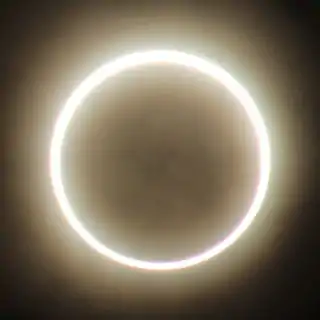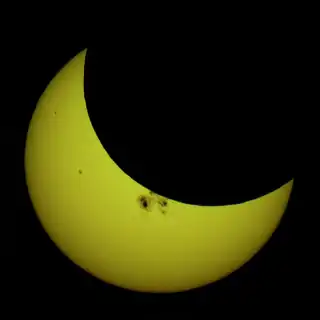Solar eclipse of December 4, 2021
A total solar eclipse took place on Saturday, December 4, 2021, when the Moon passed between Earth and the Sun, thereby totally or partly obscuring the image of the Sun for a viewer on Earth. This eclipse was unusual as the path of the total eclipse moved from east to west across West Antarctica, while most eclipse paths move from west to east. This reversal is only possible in polar regions. Its path across Antarctica crossed near Berkner Island, traversed an arc over the continent and passed over Shepard Island.[1][2]
| Solar eclipse of December 4, 2021 | |
|---|---|
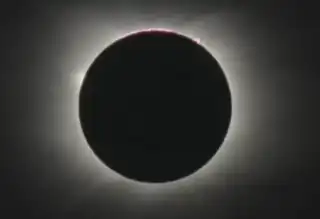 Totality viewed from Union Glacier Camp, Antarctica | |
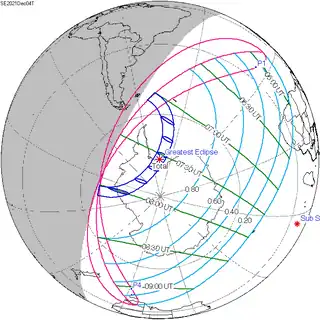 Map | |
| Type of eclipse | |
| Nature | Total |
| Gamma | −0.9526 |
| Magnitude | 1.0367 |
| Maximum eclipse | |
| Duration | 114 sec (1 m 54 s) |
| Coordinates | 76.8°S 46.2°W |
| Max. width of band | 419 km (260 mi) |
| Times (UTC) | |
| Greatest eclipse | 7:34:38 |
| References | |
| Saros | 152 (13 of 70) |
| Catalog # (SE5000) | 9556 |
Images
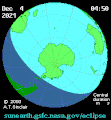 Animated path
Animated path.png.webp) NASA's DSCOVR Satellite photo
NASA's DSCOVR Satellite photo.jpg.webp) As observed by the Royal Navy (HMS Protector) off South Georgia
As observed by the Royal Navy (HMS Protector) off South Georgia
Related eclipses
Eclipses of 2021
Half-Saros cycle
- Preceded: Lunar eclipse of November 28, 2012
- Followed: Lunar eclipse of December 9, 2030
Solar Saros 152
- Preceded: Solar eclipse of November 23, 2003
- Followed: Solar eclipse of December 15, 2039
Solar eclipses of 2018–2021
This eclipse is a member of a semester series. An eclipse in a semester series of solar eclipses repeats approximately every 177 days and 4 hours (a semester) at alternating nodes of the Moon's orbit.[4]
Note: Partial solar eclipses on February 15, 2018, and August 11, 2018, occurred during the previous semester series.
| Ascending node | Descending node | |||||
|---|---|---|---|---|---|---|
| Saros | Map | Gamma | Saros | Map | Gamma | |
117.jpg.webp) Partial from Melbourne, Australia |
2018 July 13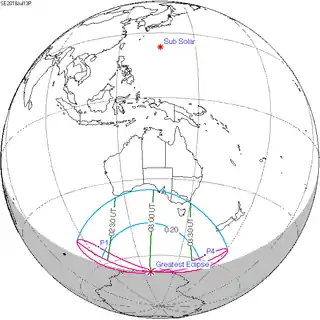 Partial |
−1.35423 | 122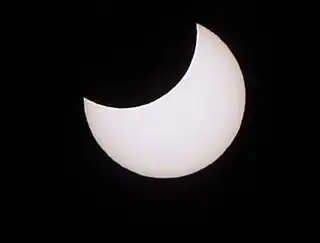 Partial from Nakhodka, Russia |
2019 January 6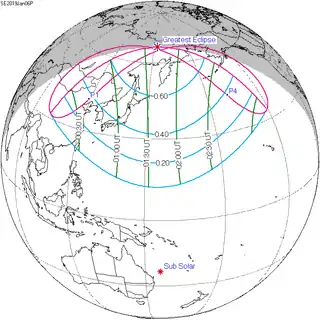 Partial |
1.14174 | |
127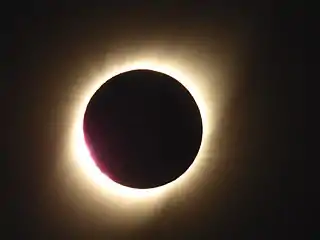 La Serena, Chile |
2019 July 2 Total |
−0.64656 | 132.jpg.webp) Jaffna, Sri Lanka |
2019 December 26 Annular |
0.41351 | |
137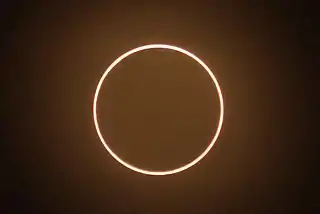 Beigang, Yunlin, Taiwan |
2020 June 21 Annular |
0.12090 | 142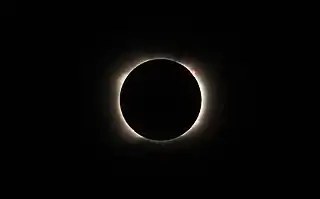 Gorbea, Chile |
2020 December 14 Total |
−0.29394 | |
147_(cropped).jpg.webp) Partial from Halifax, Canada |
2021 June 10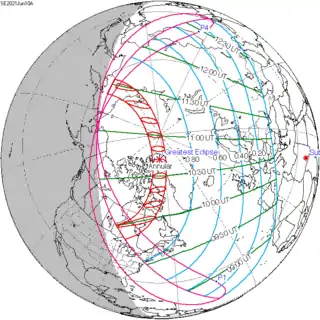 Annular |
0.91516 | 152.jpg.webp) From HMS Protector off South Georgia |
2021 December 4 Total |
−0.95261 | |
Saros 152
Solar saros 152, repeating every about 18 years and 11 days, contains 70 events. The series started with a partial solar eclipse on July 26, 1805. It has total eclipses from November 2, 1967, to September 14, 2490; hybrid eclipses from September 26, 2508, to October 17, 2544; and annular eclipses from October 29, 2562, to June 16, 2941. The series ends at member 70 as a partial eclipse on August 20, 3049. The longest total eclipse will occur on June 9, 2328, at 5 minutes and 15 seconds; the longest annular eclipse will occur on February 16, 2743, at 5 minutes and 20 seconds.[5]
| Series members 7–17 occur between 1901 and 2100: | ||
|---|---|---|
| 7 | 8 | 9 |
 September 30, 1913 |
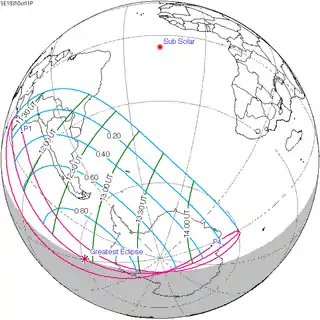 October 11, 1931 |
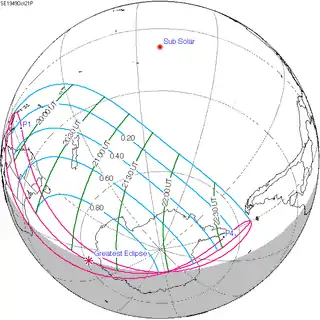 October 21, 1949 |
| 10 | 11 | 12 |
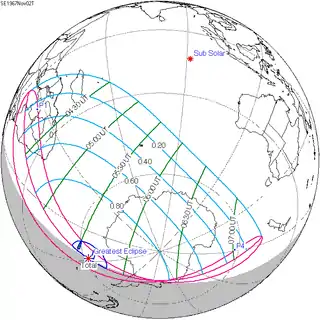 November 2, 1967 |
 November 12, 1985 |
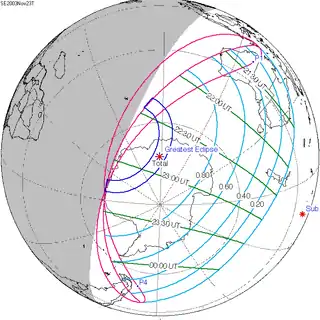 November 23, 2003 |
| 13 | 14 | 15 |
 December 4, 2021 |
 December 15, 2039 |
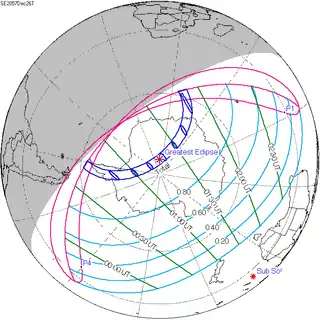 December 26, 2057 |
| 16 | 17 | |
 January 6, 2076 |
 January 16, 2094 | |
Metonic series
The metonic series repeats eclipses every 19 years (6939.69 days), lasting about 5 cycles. Eclipses occur in nearly the same calendar date. In addition, the octon subseries repeats 1/5 of that or every 3.8 years (1387.94 days). All eclipses in this table occur at the Moon's descending node.
| 21 eclipse events, progressing from north to south between July 11, 1953 and July 11, 2029 | ||||
|---|---|---|---|---|
| July 10–12 | April 29–30 | February 15–16 | December 4–5 | September 21–23 |
| 116 | 118 | 120 | 122 | 124 |
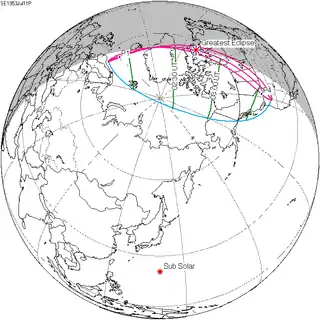 July 11, 1953 |
 April 30, 1957 |
 February 15, 1961 |
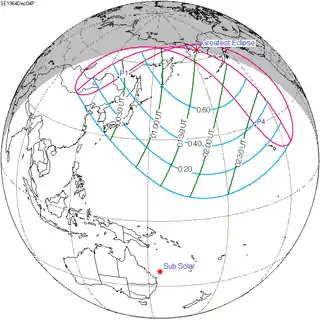 December 4, 1964 |
 September 22, 1968 |
| 126 | 128 | 130 | 132 | 134 |
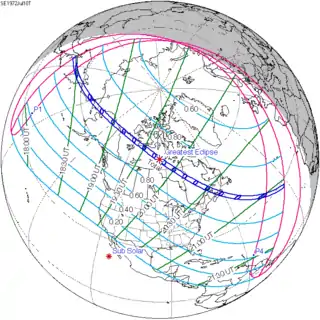 July 10, 1972 |
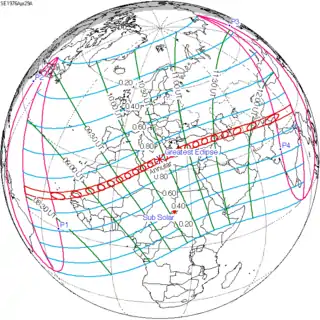 April 29, 1976 |
 February 16, 1980 |
 December 4, 1983 |
 September 23, 1987 |
| 136 | 138 | 140 | 142 | 144 |
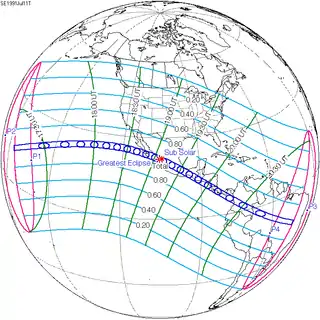 July 11, 1991 |
 April 29, 1995 |
 February 16, 1999 |
 December 4, 2002 |
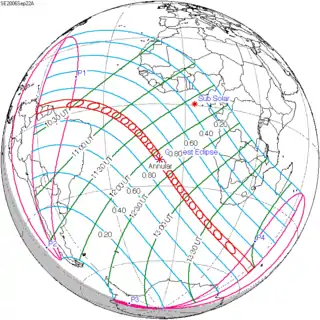 September 22, 2006 |
| 146 | 148 | 150 | 152 | 154 |
 July 11, 2010 |
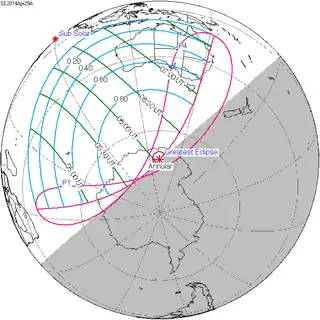 April 29, 2014 |
 February 15, 2018 |
 December 4, 2021 |
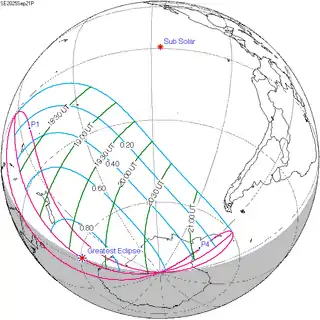 September 21, 2025 |
| 156 | 158 | 160 | 162 | 164 |
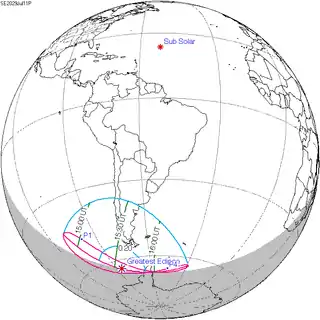 July 11, 2029 | ||||
Notes
- "NASA – Total Solar Eclipse of 2021 December 04".
- Rao, Joe (5 December 2021). "Here's what the only total solar eclipse of 2021 was like from a cruise ship near Antarctica". Space.com. Archived from the original on 6 December 2021.
- "Explained: Total lunar eclipse and supermoon – the two celestial events on May 26". The Indian Express. 2021-06-01. Retrieved 2021-12-04.
- van Gent, R.H. "Solar- and Lunar-Eclipse Predictions from Antiquity to the Present". A Catalogue of Eclipse Cycles. Utrecht University. Retrieved 6 October 2018.
- Saros Series Catalog of Solar Eclipses NASA Eclipse Web Site.
References
- solar-eclipse.de: The total solar eclipse of 12/04/2021
- Earth visibility chart and eclipse statistics Eclipse Predictions by Fred Espenak, NASA/GSFC
.jpg.webp)
